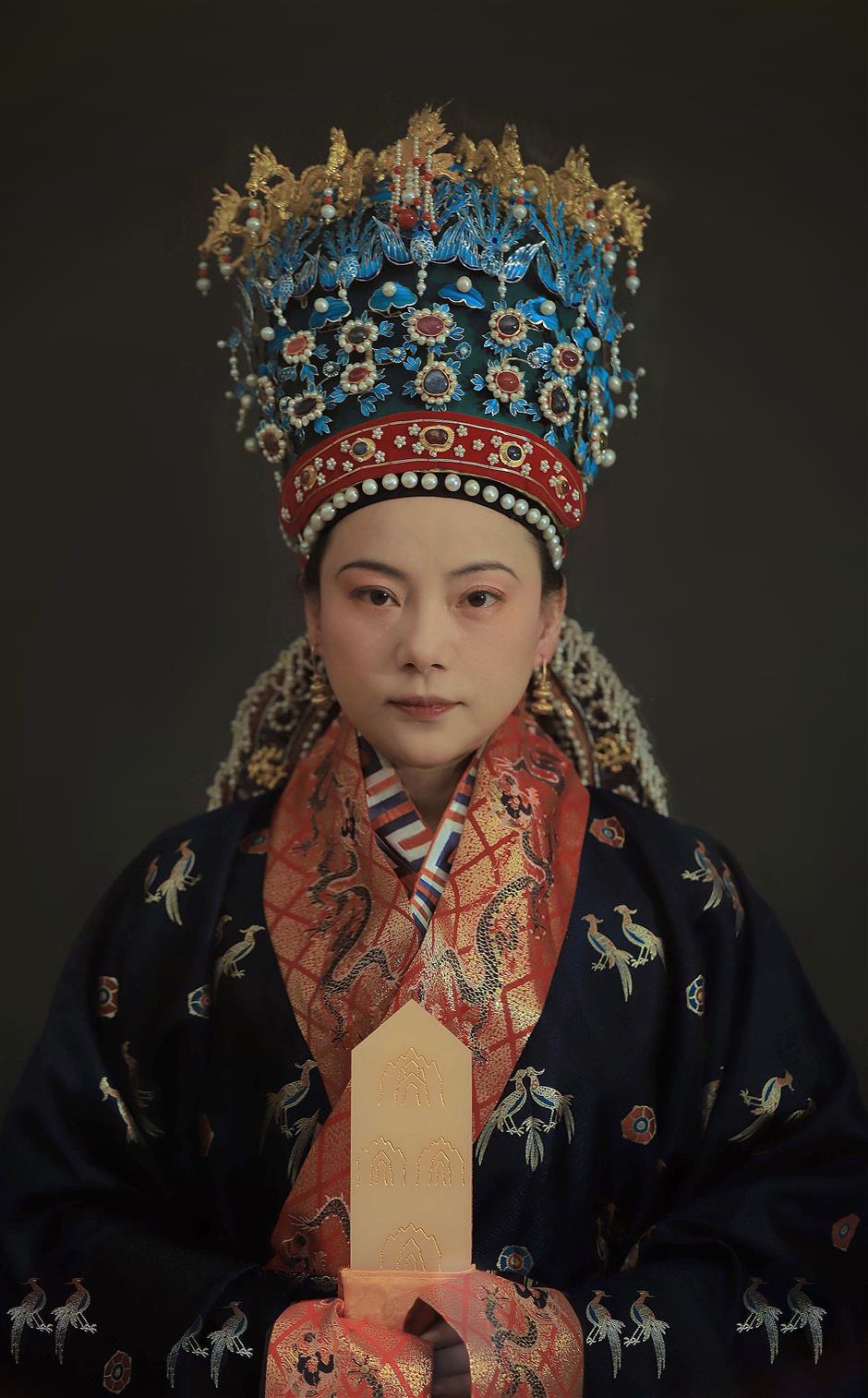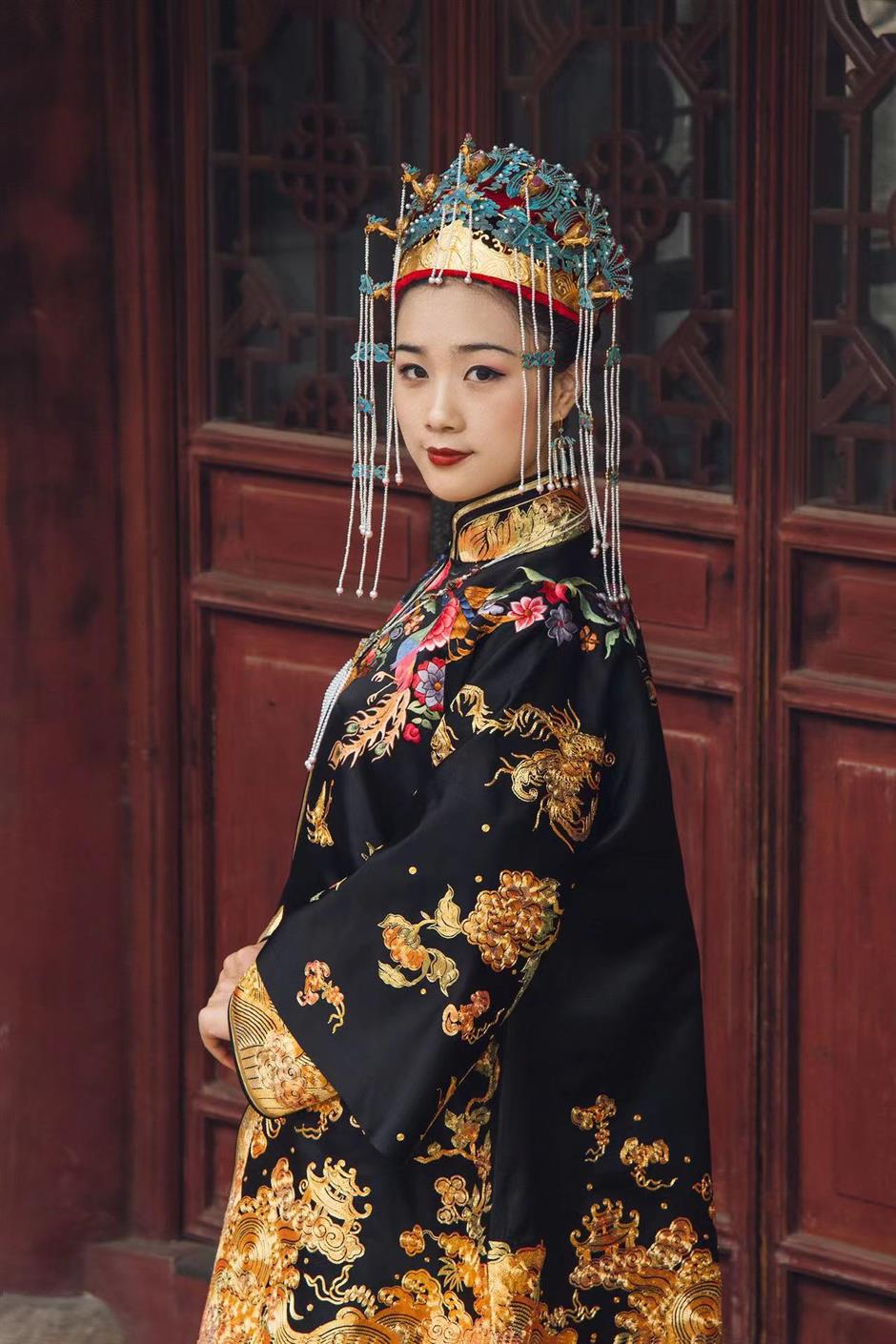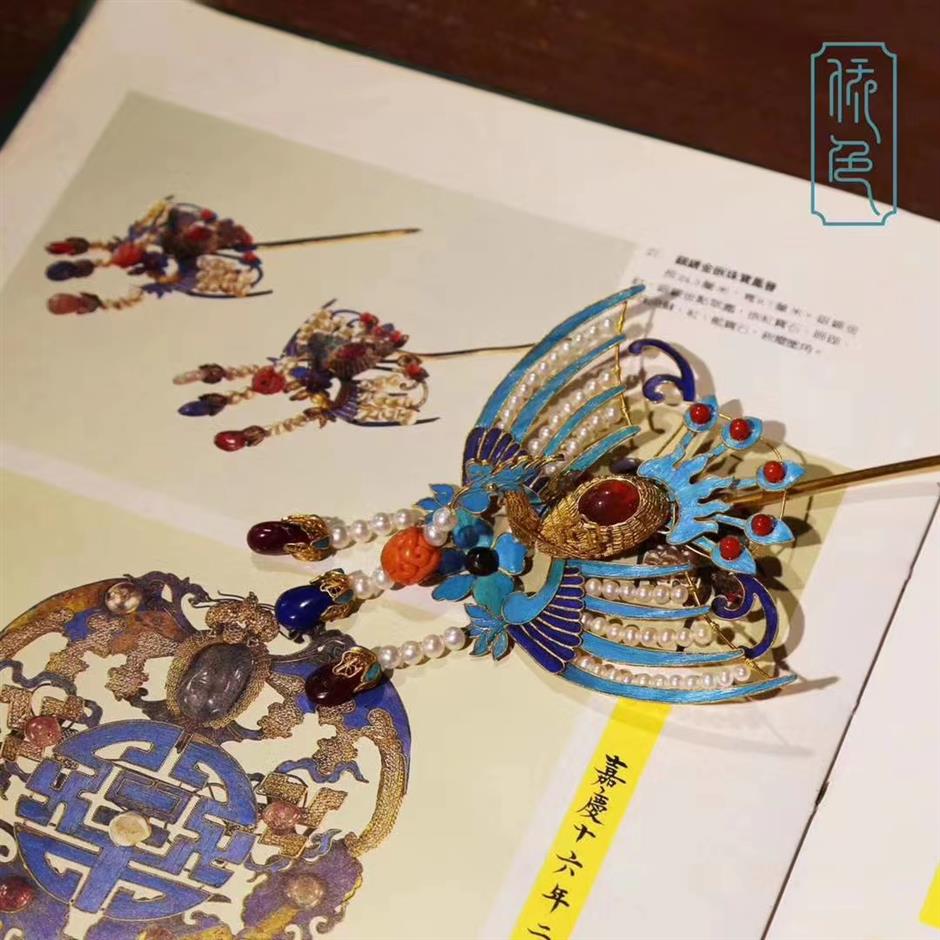Young designer's workshop recreating glorious headwear of past
Headgear of Nine Dragons and Nine Phoenixes

Headgear of Nine Dragons and Nine Phoenixes
-

Using the highest-level fengguan in the Ming Dynasty as a prototype, the headgear has nine dragons with filigree inlay technique and nine phoenixes with diancui technique. It’s decorated with gold beasts, old ruby, sapphire from the Ming and Qing dynasties and nearly 10,000 pearls. On the top, there’s a 20-carat red tourmaline and an ancient pearl. It took Xie Jingchen two years to complete.
Ti Gong -

Designer Xie Jingchen, 25, last month completed a replica of a Ming Dynasty (1368-1644) fengguan, or phoenix coronet, which is a traditional type of Chinese headgear for noblewomen and brides.
Xie also uploads videos to platform Bilibili showcasing how to make replicas of ancient jewelry adornments with the intangible cultural heritage skill, Chongqing-style filigree inlay, how to dress with the adornments and create the ancient hairstyle as well as knowledge about traditional culture and ceremonies.
He has nearly 290,000 followers on Weibo and 57,000 followers on Bilibili.
Brought up in a family engaged in traditional culture, Xie said he developed his interest in traditional Chinese crafts in his childhood. After graduating from university, he started to go in for filigree inlay.
Queen's Fengdian in Qing Dynasty

Queen's Fengdian in Qing Dynasty
-

Dian is a woman’s hair ornament of gold flowers, of which there are three types — fengdian, mandian and bandian, differing in materials and style. Fengdian is a special one worn by Manchu women when they are dressed in formal robes. The original one is now kept in the Taipei Palace Museum. It is one of the existing top-level fengdians worn by the queen. With a pattern of 20 phoenixes on it, the fengdian has more than 100 pieces of ruby, sapphire and tourmaline, and nearly 10,000 pearls.
Ti Gong -

-

-

-

Queen's Fengdian in Qing Dynasty
Dian is a woman's hair ornament of gold flowers. It has three types —— fengdian, mandian and bandian, differing from the materials and style. Fengdian is a special one that worn by Manchu women when they are dressed in formal robes. The original one is now kept in the Taipei Palace Museum, which is one of the existing fengdians at highest level and worn by the queen. With the pattern of 20 phoenixes on it, the fengdian has more than 100 pieces of ruby, sapphire and tourmaline, as well as nearly 10,000 pearls.
"Filigree inlay has a long history and during the Spring and Autumn (770-476 BC) and Warring States (475-221 BC) periods, there was a skill called jinyincuo, which is the prototype of filigree inlay," Xie explained. "In the Ming and Qing dynasties (1644-1911), it achieved its greatest prosperity with jewelry mainly made with it. The best pieces were exclusively provided for noble families."
There are different genres for filigree inlay, Xie said. The Chongqing-style filigree inlay is more elaborate and mainly used for jewelry, while the Beijing-style is also applied on making larger things such as bottle and ornaments.
Headgear of Nine Phoenixes and Peony

Headgear of Nine Phoenixes and Peony
-

Generated from the nine-phoenix headgear of Qing Dynasty imperial Han ethnic concubine and noblewomen, this fengguan has a pattern of clouds on its body with nine phoenixes using diancui technique. Jewels are inserted on the phoenixes. On the top of the headgear, there’s a peony with two bats on its sides — in Chinese, bat has the same pronunciation as blessing, all made with diancui technique. In the middle of the peony, it’s coral.
Ti Gong -

-

-

Xie is a partner of the Qiaose Intangible Cultural Heritage Jewelry Workshop in Suzhou which provides two kinds of products, one is the replica of cultural relics and the other is modern jewelry with filigree inlay and diancui technique, which applies bird feathers onto accessories.
Though he majored in science and engineering, Xie said he learnt painting when he was a little boy and likes designing. When he was at university, he opened a Weibo account and released postings such as appreciation of cultural relics and antiques and the evolution of attire in the Ming and Qing dynasties.
Headgear of Seven Phoenixes and Two Dragons Playing with a Pearl

Headgear of Seven Phoenixes and Two Dragons Playing with a Pearl
-

This headgear was worn by Han ethnic noblewomen in the Ming and Qing dynasties when they were receiving titles of nobility, meeting the emperor, during a wedding ceremony or celebrating festivals. It was the most important item for women at that time. It took nearly 5,000 hours and some 30 people to make it. Its prototype was the headgear of a Han ethnic queen or imperial concubine in the period under the rule of Emperor Qianlong in the Qing Dynasty.
Ti Gong -

-

-

-

-

-

-

-

"It also has something to do with my hobby and the business of the workshop," he said.
"Since the workshop mainly makes jewelry of the court of the Ming and Qing dynasties, many fans were curious about how the noblewomen wore the jewelry and how they dressed. Then I started to 'restore' the attire, which can let them know the real look of tradition culture so that they won't be misled by some TV dramas."
But when bringing the traditional look to an audience, they faced lots of challenges.
"For example, we want to 'restore' the look with attire and makeup of Qing Dynasty," he said. "We can make the jewelry but it's difficult to get the clothes. To better show the audience, we always use the antique clothes so that I have to spend a year to prepare for it."

Xie Jingchen
Once an attire of the early Qing Dynasty had a gold phoenix ornament on it, Xie said. Although they can make a similar one, some details would be different from the original one because the technique they use is different. Later he found an antique one and spent lots of money to restore it, which can both be used on the attire and taken as a reference for making replica.
"For a complex workpiece, it can take one or two years to do preparation, draw sketches, start to make it and understand its technique. How long it will take mainly depends on the jewelry's technique and design."
Besides recording how they made the ornaments and restore the attire, he also filmed videos about how an ancient queen spent her day of solar term dongzhi, or Winter Solstice, in the imperial harem.
"That provides comprehensive knowledge about the ancient culture, much more than the attire and jewelry," he said. "It shows the inner decorations, etiquette and special scenes like paying respect for Buddha."

The attire of a traditional Chinese bride made by Qiaose.
They also invited some lama, referring to Buddhist monks in Tibet, to join the filming.
Sometimes the videos can have unexpected feedback.
Once Xie posted a video that introduced an antique silver hair clasp in Guangdong's Chaoshan area. One of his fans contacted him and said she used to have one in her departed grandma's home but it was damaged.
In her hometown, there's a custom for the bride to wear the headwear with local characteristics. She wanted to find an old one which was almost the same but noticed that most of the similar hair clasps in the market are combined with modern styles.

Headgear and attire are in tune.
She asked if she could buy the one in the video and Xie agreed. Then she wore the hair clasp at her wedding and felt her grandma was with her.
"Many customers buy fengguan from our workshop for their Chinese wedding ceremonies," he said.
"Then it will be well kept and later passed to their daughter or daughter-in-law when the latter get married. Such inheriting is part of the traditional Chinese culture. The fengguan is not just a headgear but something that carries the mom's blessing to the younger generation. I think it's very meaningful."
Chinoiserie has now become a new lifestyle for young people, and the booming popularity of short videos has promoted it in more creative ways.
On Bilibili, there're many more uploaders like Xie that share Chinoiserie-style videos.

A model strikes a pose.
Another uploader Caiqian impressed thousands of netizens by using gold to replicate signature cultural relics uncovered from the Sanxingdui Ruins in Sichuan Province. His video showcasing the process of making a golden rod, which requires four months of labor, has been viewed more than 8 million times on the major online video platform.
The creations of uploader Yanhong Aimee, who makes traditional ornaments with unexpected materials such as waste cans, dead branches, peacock feathers and gold wire, have been worn by models at Milan Fashion Week.
"Sugar King" Zhou Yi makes fondant cake with Chinese-style elements and brings them to the world stage, which has garnered him many awards. The figures on his cakes include a mythological goddess, banshee-like nine-tailed fox, moon goddess Chang'e and ancient heroines like Hua Mulan and female poet Tang Wan.

A regal look.
Data shows that by the end of October, there were more than 2 million Chinoiserie videos on Bilibili and the number of viewers reached 136 million in the past year.
"It's a good trend," Xie said. "The popularization of the Internet and the greater emphasis given to traditional Chinese culture, as well as the young people's love toward it, are really helpful for industries like ours, which make traditional craft."
To meet the taste of young people, his workshop also combines the traditional techniques with modern designs on works like earrings and brooches. These works are well fit with modern clothes and people can also have the workshop to customize their own.
Xie and the workshop plan to draw sketches of more different kinds of fengguan from the Ming to Song dynasties and bring them to the real world.
"Then there will be an exhibition of Chinese fengguan," he said.

A hairpin made with diancui and filigree inlay techniques.

A bracelet made with filigree inlay technique.

A brooch made with diancui and filigree inlay techniques.















